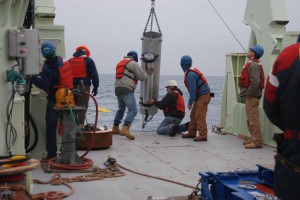
Pete Liarakos, bosun, guides the sound source over the aft deck as part of the mooring deployment. The mooring is deployed top to bottom, anchor last. This means that the sound source appears upside-down in this picture, but will be oriented 180 degrees from this in the water once the anchor is deployed. This source is located on the western flank of the Reykjanes Ridge, and will insonify the Irminger Basin at a frequency that the floats are programmed to receive.
This morning we woke up early to get ready for the first sound source mooring deployment on this cruise leg. As described in earlier posts, the sound sources will be used to track subsurface floats drifting with the deepest currents in the North Atlantic. Each sound source will transmit an 80-second long acoustic tone once every day. the floats are programmed to listen for those signals and record when it hears them. Knowing when the signal was transmitted, when the float heard it and the speed of sound in water, we can estimate the distance from each sound source to the float. With at least two sound sources, we are able to determine the position of the float every day.
Sounds simple enough? Well, it’s pretty complex to get all this equipment into the ocean. I call it “industrial oceanography”. The first step was to find a position where the ocean depth was just right. This requires the use of a special echo-sounder which is installed on the hull of the ship. It provides a map of the sea floor depth (like a topographic map) with a lot of detail. This is where I just have to rely on colleagues with normal vision. The echo-sounder and its display are specialized and its not possible to get the maps displayed on my large monitor. This frustrates me – access to graphical information is really important to what I do but so far, I haven’t found any real substitute for vision when it comes to analyzing many complex images coming in rapid succession.
Well, that is that, and with colleagial assistance, we found a good spot for the mooring on the western flank of the mid-Atlantic ridge. This is a very rugged region, with many hills and valleys. We gave the latitude and longitude to the officer on watch and he set the ship in a good position to start the mooring. the top of the mooring is put over the stern of the ship first, and as we let out more wire, the “string” trails out behind us as we motor along at about 1-2 knots (nautical miles per hour). The sound source is then attached to the wire, then lots more plain wire, then the acoustic release goes over, and finally, the very heavy anchor is lowered over the stern and released. This all takes about one and a half hours and is done by a combination of ship crew members and technicians. Unfortunately, it is impossible for me to participate in any deck operations. There are cranes, wires and rope under high tension, hand signals are used a lot to communicate because of the background noise. ,
A good indication of how deep the ocean is (it was 2600 meters at the mooring site) is that it takes 15-20 minutes for the anchor to sink to the sea floor, even though it weighs more than 2000 pounds. It’s a long way to the bottom–over a mile!
After the anchor hits the sea floor, we stick around and talk to the release with pings to make sure it is happy. We then put the release “to sleep”–the state it will stay in for four years, at which point, someone in our project will come back, wake up the release, and tell it to let go of the anchor. That is how we get the sound source back so we can use it for another project in the future. Only the anchor and some chain is left behind on the sea floor. Recycling!

 Amy Bower is a physical oceanographer at the Woods Hole Oceanographic Institution. She has been chasing ocean currents in the Atlantic and Indian Oceans for over 25 years, primarily by releasing acoustically tracked floats far below the sea surface. Legally blind since her mid-20s, Amy uses adaptive technology to continue her research.
Amy Bower is a physical oceanographer at the Woods Hole Oceanographic Institution. She has been chasing ocean currents in the Atlantic and Indian Oceans for over 25 years, primarily by releasing acoustically tracked floats far below the sea surface. Legally blind since her mid-20s, Amy uses adaptive technology to continue her research.